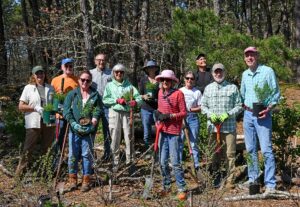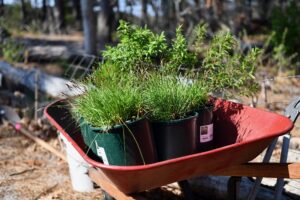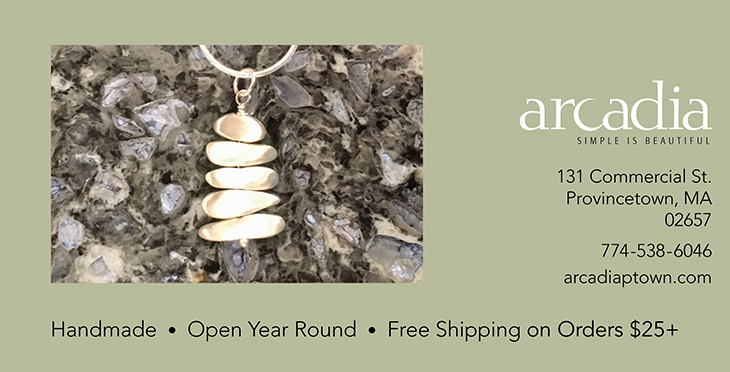EASTHAM — Step into the woods near Wiley Park and you’ll find yourself stepping back in time. That’s the idea, at least. Since 2001, Eastham’s 1651 Forest Advisory Committee has been working to preserve a stretch of woodland reminiscent of what European settlers might have seen when they first incorporated the town in 1651.

Most of the committee’s dirty work gets done by the Friends of the Eastham 1651 Arboretum, a volunteer group. On May 3, the Friends carried out their first major project of the year, planting native winterberry, Pennsylvania sedge, and clethra (also known locally as summersweet or sweet pepperbush) in a section of dog-trampled ground between the trail and Great Pond.
The group focuses on areas of the forest that are struggling, says Steve Gulrich, president of the Friends. “We’re trying to bring back native species that were here previously but haven’t been able to compete, or haven’t been attended to, or have been overgrown,” he says.
The May 3 work was mainly focused on restoring habitat degraded by stormwater runoff, says Liz Strzetelski, a sustainable landscape designer who has been on the Friends’ board of directors for eight years. “When it rains, the water runs really quickly through the areas where there are paths,” she says, potentially ruining habitats for animals like the eastern painted turtle, especially in sloping areas near the water’s edge.

Strzetelski chooses which species the Friends will plant and where to plant them to best redirect water in a way that won’t harm the habitat. Pointing to the sweet pepperbush, she says, “We want the roots to knit together into the pond’s edge to maintain the soils and the habitat.”
It’s a delicate balance, Gulrich says, especially because there’s been increased foot traffic in recent decades, starting with the geocachers of the early 2000s and others who find the spot on social media. And, he adds, “when the summer comes, we get large groups of people coming through with many dogs.” His group’s goal is to keep it safe and attractive, he says, adding, “We obviously have to work in cooperation with the Eastham Dog Owners’ Association.”
The town’s five-member advisory committee is composed of the president of the Friends, a representative from the open space committee, and a representative from the conservation commission, as well as two others. One of those two slots is currently vacant; the other is held by Henry Lind, who acts as the committee’s secretary.

The committee had its origins in the town’s 350th anniversary celebration, which was held in 2001. Dennis Murley, then-chairman of the Eastham Conservation Commission, suggested putting some celebration funds into the forest near Wiley Park with the goal of “the creation of a forest of indigenous trees, those species that were here in 1651 when the town was incorporated,” according to the 2001 Town Report.
The idea, Lind says, was that by the time the town celebrates its 450th anniversary in 2101, visitors would be able to step into a replica of the forest that existed before the trees were cut down to create farmland in the 17th and 18th centuries.
“It was a great plan, and it was well intentioned,” says Lind, who was Eastham’s natural resource officer at the time and had been working for the town since 1975, including as shellfish constable and harbormaster. “We attempted to use as much data as we could from some of the early journals that were transcribed by the first settlers.”

The most famous of those journals is Mourt’s Relation, written in 1620 and 1621 by Edward Winslow and William Bradford, who went on to govern the Plimoth Colony. Both were separatists from England and signers of the Mayflower Compact. The journal’s full title, A Relation or Journal of the beginning and proceedings of the English Plantation settled at Plimoth in New England, reveals the roots of a problem the Friends had while attempting to recreate the elm forest the journal described.
“The elms died off like crazy,” Lind says. That’s because the journal was probably describing forests on the Upper Cape, not the ones the colonists would have encountered in Eastham, where the soil is much sandier.
So, the committee went back to the drawing board and found a 2002 study conducted by Glenn Motzkin of Harvard University. Motzkin had analyzed the charred remains of fire-damaged trees at the bottom of the Cape’s freshwater ponds. His conclusion, Lind says, is that “what the first settlers saw was probably a pine forest, just like we have today.”

That didn’t mean the group’s goal had changed; just that they had to switch from planting new species to protecting the ones already there. There are distinct challenges, Strzetelski says, to maintaining that same “primeval” pine forest in the 21st century. Newly invasive species like the southern pine beetle pose a threat to the trees’ survival, for instance.
But challenges have only helped the group to reframe its goals, Strzetelski says. “Historically, we’ve been focused on past generations,” she says. “But we’re doing this for future ones.”
The advisory committee faced its own problems in the mid-2010s, culminating in its brief dissolution for a few weeks in late 2014. Loretta Neilsen, then-president of the Friends, had asked the select board to consider disbanding the committee, which was meeting irregularly and seemed not to be necessary as oversight for the continued activities of the Friends.

Lind says there was also a hidden issue back then that had the two groups working at cross-purposes: Neilsen, Lind says, “was adamant about planting exotic species in the forest to make it look pretty.” In any case, he adds, disbanding the town’s committee wasn’t actually possible under state statute, because a Friends group can’t work on town property on its own.
So, the committee was reinstated, and Lind, who had retired from town service in 2009, was invited to join. He’s remained on it ever since.
One other hurdle for the 1651 project to overcome is perhaps a word that lingers in the Friends’ group’s name. “Arboretum” suggests a curated botanical garden, not a wild forest. Lind says that gives the wrong impression; he calls the word choice “Disneyesque.”
“It’s not intended as an arboretum,” Lind says. “It’s intended as a forest.”
Plantsman Joe Beuerlein takes a walk in the 1651 Forest on page B1.



